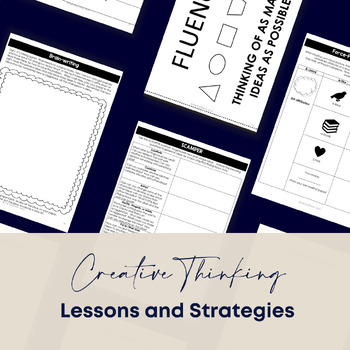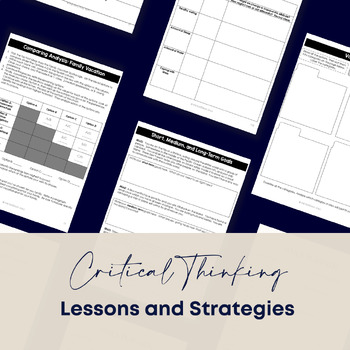Thinking Outside the Box- Using Creative and Critical Thinking Skills
- PDF
What educators are saying
Description
“I cannot teach anyone anything. I can only make them think.” ~Socrates
Utilizing this unit, your students will learn higher-order thinking skills including both creative thinking and critical thinking skills. Students will go beyond basic observation of facts and memorization. Through explicit instruction students to become more evaluative, creative and innovative in their thinking.
This unit includes multiple teaching methodologies with variations on each for extended application. Through this unit, students will be explicitly taught skills and strategies to use when thinking creatively and critically to solve problems.
Included in this resource:
- Background information on Higher Order Thinking Skills, Creativity and Critical Thinking.
- Lessons to develop the concept of Higher Order Thinking Skills.
- Introductory lessons on the Creative Thinking Processes using picture books.
- Introductory lessons on the Critical Thinking Processes using picture books.
- Thinking Frameworks to guide students in using the Creative Thinking Strategies: Brainstorming, Brain-Drawing, Brain-Writing, Force-Fitting, Synectics, SCAMPER, Morphological Matrix, and Attribute Listing.
- Thinking Frameworks to guide students in using the Critical Thinking Strategies: Vote and Sort, Evaluation Matrix, Comparison Analysis, Plus-Minus-O, Interesting, and Sequencing Goals.
- Full implementation Lessons on Using the Creative Problem Solving Model with Content.
- Natural Disasters
- Endangered Animals
- Healthy Living
- Just So Stories
- Good Citizenship
- Rubrics for assessment
- Creative Thinking Warm Ups
*****************************************************************************
Customer Tips: How to get TPT credit to use on future purchases: • Please go to your My Purchases page (you may need to login). Beside each purchase you'll see a Provide Feedback button. Simply click it and you will be taken to a page where you can give a quick rating and leave a short comment for the product. Each time you give feedback, TPT gives you feedback credits that you use to lower the cost of your future purchases. I value your feedback greatly as it helps me determine which products are most valuable for your classroom so I can create more for you. ☺
Be the first to know about my new discounts, freebies and product launches: • Look for the green star next to my store logo and click it to become a follower. Voila! You will now receive email updates about this store. ☺ *****************************************************************************





